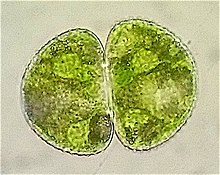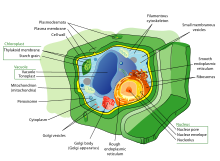Osisi

Osisi na-abụkarị photosynthetic eukaryotes, na-akpụ alaeze Plantae. Ọtụtụ bụ multicellular. N'akụkọ ihe mere eme, alaeze osisi ahụ gụnyere ihe niile dị ndụ na-abụghị anụmanụ, gụnyere algae na fungi. Nkọwa niile dị ugbu a na-ewepu fungi na ụfọdụ algae. N'otu nkọwa, osisi na-etolite clade Viridiplantae (Latin maka "osisi akwụkwọ ndụ akwụkwọ ndụ") nke mejupụtara algae ndụ ndụ na embrayophytes ma ọ bụ osisi ala. Nke ikpeazụ gụnyere hornworts, liverworts, mosses, lycophytes, ferns, conifers na gymnosperms ndị ọzọ, na osisi okooko. Nkọwa dabere na genome gụnyere Viridiplantae, yana algae na-acha uhie uhie na glaucophytes, na clade Archaeplastida.
Osisi ndụ ndụ ndụ na-enweta ọtụtụ ike ha site na ìhè anyanwụ, na-eji chloroplasts sitere na endosymbiosis na cyanobacteria. Chloroplasts na-eji chlorophyll pigment eme photosynthesis, nke na-enye ha agba ndụ ndụ. Ụfọdụ osisi na-ata ahụhụ, ha enwekwaghị ike imepụta chlorophyll nkịtị ma ọ bụ photosynthesize. A na-eji osisi eme ihe site na mmeputakwa mmekọahụ na mgbanwe nke ọgbọ, mana mmeputakwa asexual bụkwa ihe a na-ahụkarị.
E nwere ihe dị ka ụdị osisi 380,000 a maara, nke ọtụtụ n'ime ha, ihe dị ka 260,000, na-emepụta mkpụrụ. Osisi ndị na-acha akwụkwọ ndụ akwụkwọ ndụ na-enye oke nke ikuku oxygen nke ụwa ma bụrụkwa ihe ndabere nke ọtụtụ usoro okike nke ụwa. Mkpụrụ, mkpụrụ osisi, na akwụkwọ nri bụ nri ụmụ mmadụ bụ isi ma bụrụ ndị a zụlitere kemgbe ọtụtụ puku afọ. Osisi nwere ọtụtụ ọdịbendị na ihe ndị ọzọ, dị ka ihe ịchọ mma, ihe owuwu, ihe ederede, na, n'ọtụtụ ihe dị iche iche, ha abụwo isi iyi nke ọgwụ. A maara ọmụmụ sayensị nke osisi dị ka botany, alaka nke ihe ndị dị ndụ.
Echiche ndị ọzọ
[dezie | dezie ebe o si]| Aha (s) | Ebe ọ na-aga | Nkọwa |
|---|---|---|
| Osisi ala, nke a makwaara dị ka Embryophyta | Plantae sensu strictissimo | Osisi n'echiche siri ike gụnyere liverworts, hornworts, mosses, na vascular plants, yana fossil plants yiri ndị a dị ndụ (dịka, Metaphyta Whittaker, 1969, Plantae Margulis, 1971).[1][2] |
| Osisi ndị na-acha akwụkwọ ndụ akwụkwọ ndụ, nke a makwaara dị ka Viridiplantae, Viridiphyta, Chlorobionta ma ọ bụ Chloroplastida | Plantae sensu stricto | Osisi n'echiche siri ike gụnyere algae na-acha akwụkwọ ndụ akwụkwọ ndụ, na osisi ala ndị pụtara n'ime ha, gụnyere nkume. A ka na-arụ ọrụ mmekọrịta dị n'etiti ìgwè osisi, aha ndị e nyere ha dịgasị iche iche. Cl<i id="mwiw">a</i>de Viridiplantae na-agụnye otu ìgwè nke ihe ndị dị ndụ nwere cellulose na mgbidi mkpụrụ ndụ ha, nwere chlorophylls a na b ma nwee plastids ejikọtara naanị membrane abụọ nwere ike photosynthesis na ichekwa starch. Nke a bụ isi isiokwu nke isiokwu a (dịka, Plantae Copeland, 1956).[3] |
| Archaeplastida, nke a makwaara dị ka Plastida ma ọ bụ Primoplantae | Plantae sensu lato | Osisi n'echiche sara mbara gụnyere osisi ndị na-acha akwụkwọ ndụ akwụkwọ ndụ edepụtara n'elu tinyere algae na-acha ọbara ọbara (Rhodophyta) na algae glaucophyte (Glaucophyta) nke na-echekwa starch Floridean n'èzí plastids, na cytoplasm. Nke a na-agụnye ihe niile dị ndụ nke eons gara aga nwetara chloroplasts ha bụ isi site na ilo cyanobacteria (dịka, Plantae Cavalier-Smith, 1981).[4] |
| Nkọwa ochie nke osisi (nke ochie) | Plantae sensu amplo | Osisi n'echiche sara mbara na-ezo aka na nke ochie, nke ochie nke na-etinye ìgwè ndị na-enweghị njikọ nke algae, fungi na nje bacteria na Plantae (dịka, Plantae ma ọ bụ Vegetabilia Linnaeus, Plantae Haeckel 1866, Metaphyta Haeckel, 1894, Plantae Whittaker, 1969).[5][6][7][1] |
Ọdịdị
[dezie | dezie ebe o si]
| Informal group | Division name | Common name | No. of living species |
|---|---|---|---|
| Green algae | Chlorophyta | Green algae (chlorophytes) | 3800–4300 |
| Charophyta | Green algae (e.g. desmids & stoneworts) | 2800–6000 | |
| Bryophytes | Marchantiophyta | Liverworts | 6000–8000 |
| Anthocerotophyta | Hornworts | 100–200 | |
| Bryophyta | Mosses | 12000 [8] | |
| Pteridophytes | Lycopodiophyta | Clubmosses | 1200 [9] |
| Polypodiophyta | Ferns, whisk ferns & horsetails | 11000 [9] | |
| Spermatophyte (seed plants) |
Cycadophyta | Cycads | 160 [10] |
| Ginkgophyta | Ginkgo | 1 [11] | |
| Pinophyta | Conifers | 630 [9] | |
| Gnetophyta | Gnetophytes | 70 [9] | |
| Magnoliophyta | Flowering plants | 258650 |

When reproducing sexually, plants have complex lifecycles involving alternation of generations. One generation, the sporophyte, which is diploid (with 2 sets of chromosomes), gives rise to the next generation, the gametophyte which is haploid (with one set of chromosomes), and in some plants reproduces asexually via spores. In non-flowering plants such as mosses and ferns, the sexual gametophyte forms most of the visible plant.[12] In seed plants (gymnosperms and flowering plants), the sporophyte forms most of the visible plant, and the gametophyte is very small. Flowering plants reproduce sexually using flowers, which contain male and female parts: these may be within the same (hermaphrodite) flower, on different flowers on the same plant, or on different plants. Male pollen enters the ovule to fertilize the egg cell of the female gametophyte. Fertilization takes place enclosed within the carpels or ovaries, which develop into fruits that contain seeds. Fruits may be dispersed whole, or they may split open and the seeds dispersed individually.[13]
- Ebe nchekwa data botanical na ahịhịa
- Ebe nchekwa data nke African Plants Initiative
- Australia
- Osisi ndị dị na Chile na Chilebosque
- e-Floras (Flora of China, Flora of North America and others) E debere ya na Wayback Machine
- Flora Europaea
- Flora nke Central Europe (n'asụsụ German)
- Flora nke North America E debere ya na Wayback Machine
- Ndepụta nke Japanese Wild Plants Online E debere ya na Wayback Machine
- Zute Ogige Botanical nke Mba Tropical
- Lady Bird Johnson Wildflower Center - Native Plant Information Network na Mahadum Texas, Austin
- Ngalaba Ọrụ Ugbo nke United States abụghị nanị maka ụdị US
Templeeti:BotanyTempleeti:Eukaryota classificationTempleeti:Nature navTempleeti:Horticulture and GardeningTempleeti:Life on Earth
- ↑ 1.0 1.1 Whittaker (1969). "New concepts of kingdoms or organisms". Science 163 (3863): 150–160. DOI:10.1126/science.163.3863.150. PMID 5762760. Retrieved on 4 November 2014.
- ↑ Margulis (1971). "Whittaker's five kingdoms of organisms: minor revisions suggested by considerations of the origin of mitosis". Evolution 25 (1): 242–245. DOI:10.2307/2406516. PMID 28562945.
- ↑ Copeland (1956). The Classification of Lower Organisms. Pacific Books.
- ↑ Cavalier-Smith (1981). "Eukaryote Kingdoms: Seven or Nine?". BioSystems 14 (3–4): 461–481. DOI:10.1016/0303-2647(81)90050-2. PMID 7337818.
- ↑ Linnaeus (1751). Philosophia botanica, 1st (in Latin), Stockholm: Godofr. Kiesewetter.
- ↑ Haeckel (1866). Generale Morphologie der Organismen. Berlin: Verlag von Georg Reimer.
- ↑ Haeckel (1894). Die systematische Phylogenie.
- ↑ Goffinet (2004). "Systematics of the Bryophyta (Mosses): From molecules to a revised classification". Monographs in Systematic Botany 98: 205–239.
- ↑ 9.0 9.1 9.2 9.3 Raven (2005). Biology of Plants, 7th, New York: W.H. Freeman and Company. ISBN 978-0-7167-1007-3.
- ↑ Gifford (1988). Morphology and Evolution of Vascular Plants, 3rd, New York: W.H. Freeman and Company. ISBN 978-0-7167-1946-5.
- ↑ Taylor (1993). The Biology and Evolution of Fossil Plants. New Jersey: Prentice-Hall. ISBN 978-0-13-651589-0.
- ↑ How Do Plants With Spores Reproduce?. Sciencing. Retrieved on 7 March 2023.
- ↑ Barrett (2002). "The evolution of plant sexual diversity". Nature Reviews Genetics 3 (4): 274–284. DOI:10.1038/nrg776. PMID 11967552. Retrieved on 7 March 2023.
